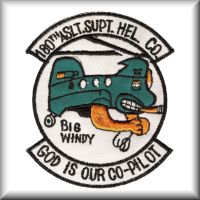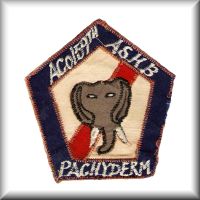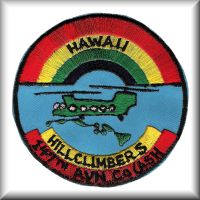 |
180th Assault Support helicopter Company "Big Windy" Vung Tau, Republic of Vietnam |
| 68-16003 |
 |
180th Assault Support helicopter Company "Big Windy" Vung Tau, Republic of Vietnam |
 |
A Company - "Pachyderms" 159th Assault Support Helicopter Battalion Fort Campbell, Kentucky |
 |
147th Assault Support Helicopter Company "Hillclimbers" Hawaii |
| 68-16003, Boeing build number B-595, was a CH-47C helicopter. The U.S. Army acceptance date was 25 August 1969. 68-16003 accumulated 3,858.03 aircraft hours. From August 1969 through October 1969, 68-16003 was in transit. From November 1969 through September 1972, 68-16003 was assigned to the 180th Assault Support Helicopter Company (ASHC) - "Big Windy", 268th Combat Aviation Battalion (CAB), 17th Combat Aviation Group (CAG), 1st Aviation Brigade, in the Republic of Vietnam (RVN). From October 1972 through November 1972, 68-16003 was assigned to the United States Army Aeronautical Depot Maintenance Center (ARADMAC), 4th Army, headquartered at Corpus Christi, Texas, presumably for return shipment to the Continental United States (CONUS). From December 1972 through June 1973, 68-16003 was assigned to the New Cumberland Army Depot (NCAD), located near Harrisburg, Pennsylvania. From July 1973 and through at least March 1974, 68-16003 was assigned A Company - "Pachyderms", 159th Aviation Battalion, 101st Aviation Group, 101st Airborne Division, Forces Command (FORSCOM), located at Fort Campbell, Kentucky. On 19 February 1974, 68-16003 suffered from number two engine failure in the vicinity of McGhee/Tyson, Tennessee. The third stage power turbine of the T55-L-11A engine failed and caused extensive damage to the fuselage structure and other systems. From April 1974 through at least decmber 1975, 68-16003 was in storage and awaiting disposition at NCAD. At some point, and through at least 7 January 1984, 68-16003 was assigned to the 147 Assault Support Helicopter Company (ASHC) - "Hillclimbers", U.S. Army Support Command, Hawaii (USASCH), FORSCOM, located initially at Schofield Barracks, and later at Barbers Point, Hawaii. On 23 February 1977, 68-16003, while assigned to the 147th ASHC USASCH, FORSCOM, at Schofield Barracks and in cruise flight, developed a high frequency vibration that began in the area of the combining transmission. It was suspected there was insufficient lubrication of an adapter. A slight binding occurred on an adapter causing the high frequency vibration. The area around the adapter had been washed at least twice since the last lubrication interval. These washings could have displaced the lubricant in the adapter. On 22 June 1977, 68-16003, while assigned the the 147th ASHC, USASCH, FORSCOM, at Barbers Point, suffered from a number one engine failure while at a 15 foot hover. The teardown and diagnostic evaluation of engine, serial number LE19431A, disclosed that failure was caused by total destruction of the inlet guide vane assembly, coupled with major damage to the compressor rotor assembly and hot end. No visible evidence of foreign object ingestion from the front end. Suspect one or more vanes from the inlet guide vane assembly failed initially from fatigue due to possible vane flutter resulting from a defective T2 sensing bellows, coupled with a seized or binding T2 sensing actuating rod. It is likely that catastrophic failure of the compressor destroyed any evidence of the cause of the failure. Metal evaluation of report indicated that the T2 bellows failed because of a leak in the bore header. The leak probably developed from the battering of the mating component against the header. On 10 January 1978, 68-16003 while assigned to the 147th ASHC, USASCH, FORSCOM, located at Barbers Point, was involved in a ground incident. 68-16003 was ground run for the purpose of tracking the forward and aft rotor systems. As the rotor stabilized at approximately 220 RPM, a round sheet metal disc which had been installed in the second window hole from the cabin entrance door flew out of the window and up through the rotor system. Then, due to rotor vortices, came back down into the rotor system. The disc struck the top of the aft green rotor blade and was thrown to the left rear of the aircraft. On 2 May 1978, 68-16003, while assigned to the 147th ASHC, USASCH, FORSCOM, located at Barbers Point, developed a hydraulic leak while in flight. The Flight Engineer noticed a hydarulic leak in the vicinity of the number one hydraulic system manifold check valve. The check valve was installed incorrectly. On 21 June 1978, 68-16003 was assigned to the 147th ASHC, USASCH, FORSOM, located at Barbers Point. The number two engine oil low light illuminated while in cruise flight. The low oil level sensing system was recalibrated and the aircraft was released for flight. On 16 November 1978, 68-16003, while assigned to the 147th ASHC, USASCH, FORSCOM, located at Barbers Point, was at a hover when the number two engine failed. While performing a hover check at 10 foot altitude, the number two engine power turbine inlet temperature (PTIT) exceeded 1000 degrees Celsius with the rotor RPM at 250 and torque at 68-75 percent. The number two engine chip light illuminated. The number two N1 speed is unknown. The use of emergency engine trim was attempted with no response. Preliminary Corpus Christi Army Depot (CCAD) report (CCAD-USASCH HI 78-12-1, CH-47C, 68-16003), explained that examination of the engine revealed major internal damage to the compressor rotor and other components of the power turbine section. The compressor rotor shaft had separated when it contacted the extended portion of the 3rd stage power shaft, part number (P/N) 2-141-350-03. The number 1, 2, 3, 6 and 7 main bearings were not damaged. The 4th stage turbine rotor had shifted aft, sufficiently, to contact the exit guide vane containment ring, P/N 2-141-480-03. Preliminary analysis indicates that engine stoppage was probably caused by failure of the number 4 and 5 main bearing. Analysis is continuing. Estimated completion date for final report is 28 February 1979. On 18 January 1979, 68-16003, while assigned to the 147th ASHC, USASCH, FORSCOM, located at Barbers Point, suffered from illumination of the number two engine chip detector. A precautionary landing was performed without incident. Final disassembly inspection report-AOAP HI 79-001, CH-47C, 68-16003 reached the following conclusions: A. Analytical investigation of engine revealed the metal on the chip detector resulted from spalling in the power shaft support bearing (#3 bearing). Laboratory analysis revealed the bearing failed through contact stress fatigue mechanisms. B. The increased level of magnesium wear metal in the oil was caused by corrosion in the oil reservoir. On 17 May 1979, 68-16003, was assigned to the 147th ASHC, USASCH, Western Command (WESTCOM). The control centering switch would not release. The pilot in command suspected battery relay failure and executed a precuationary landing. The control centering switch was discovered defective. On 2 April 1980, while assigned the the 147th ASHC, 25th Aviation Battalion, 25th Infantry Division, Western Command (WESTCOM), located at Barbers Point, Hawaii, 68-16003 was undergoing a Turbine Engine Analysis Check (TEAC) procedure. After completing number two engine topping, number one engine condition lever was moved to flight position. The torque measuring system failed and dropped to zero psi indicated. Number one engine chip light illuminated. The pilot secured number one engine and completed flight in single engine mode. The number one engine torque indicating system failed causing severe distortion of the torque measuring pick up and power shaft on which it rides. Part was replaced and aircraft was released for flight. On 15 April 1980, 68-16003, while assigned to the 147th ASHC, 25th Aviation Battalion, 25th Infantry Division, Western Command (WESTCOM) located at Barbers Point, was flown into poor wethaer conditions. The pilot started loosing visibility in heavy rain. He started a turn toward VFR conditions but could not regain VFR conditions. He initiated vertical helicopter recovery procedures and returned to home station. The navy weather forecaster had forecast light rain showers. The pilot was operating in and out of light showers. The low ambient light conditions prevented identification of unforecast heavy rain showers. The crew commended for actions. On 31 July 1990, 68-16003 was inducted into the E model program and converted to 90-00414. The last known location of 68-16003 was at Boeing during the conversion. Aircraft status: Converted to E model. |
| Related Sites |
| 180th ASHC History in the RVN |
 |
|
| Comments or Questions ? |  |
Email the Webmaster. |
|
|